Inebriation and Intoxicants
Wine Bottle Dust
A gag gift sold to wine lovers back in 1979.Given how many wineries, with attached gift shops, have sprung up in the past twenty years, I think this would sell even better today. An opportunity awaits for an entrepreneur.
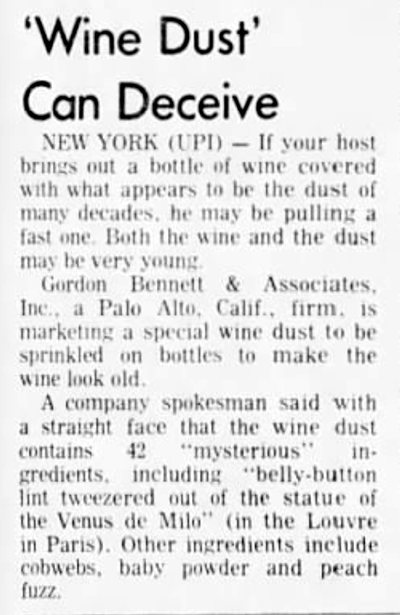
Alexandria Town Talk - Apr 19, 1979
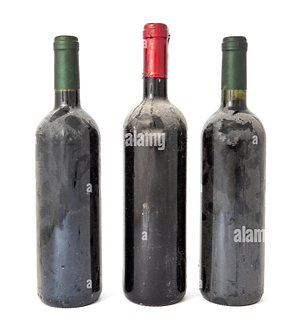
Posted By: Alex - Mon Jan 31, 2022 -
Comments (3)
Category: Imitations, Forgeries, Rip-offs and Faux, Inebriation and Intoxicants, 1970s
Muir’s Improved Pub
In 1865, temperance advocate William Muir obtained a British patent (No. 1 for 1865) for what he called "Improvements in the construction of public houses." Although whether they were actually improvements depended, I suppose, on one's point of view.Muir wanted to improve pubs first by constructing their front walls out of plate glass in order to make the interior visible to people passing by. This, he believed, would "to a great extent check drunkenness and the indecent behaviour of the persons obtaining refreshment."
Second, he wanted to make the entrances only two feet wide in order "to prevent, as far as possible, the entrance of females with extensive steel crinolines." Why prevent women wearing crinolines? He didn't elaborate. Was this some kind of code for keeping prostitutes out of the pubs?
I don't think many publicans rushed to adopt his improvements.
More info about William Muir
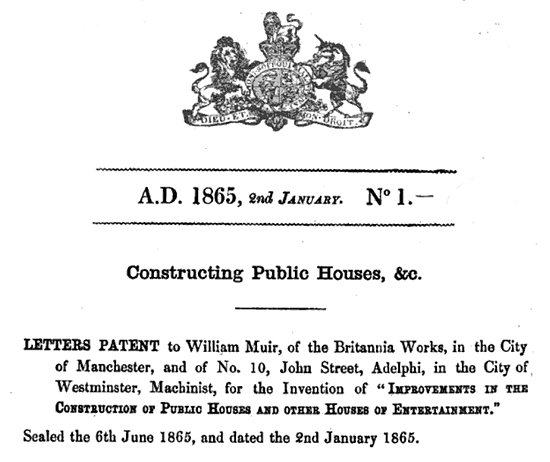
Posted By: Alex - Fri Jan 21, 2022 -
Comments (4)
Category: Inebriation and Intoxicants, Patents, Nineteenth Century
USB Wine
Since this is French, it probably won't work in the U.S.More info: usbwine.com
Posted By: Alex - Fri Jan 07, 2022 -
Comments (5)
Category: Humor, Inebriation and Intoxicants, Internet
Insect Sour
A new alcoholic beverage, "Insect Sour," on sale in Japan boasts that its main ingredient is "giant water bug extract". These water bugs are apparently popular among bug aficionados because they have "a sweet, almost fruity, flavor comparable to some types of shellfish like shrimp."I bet it pairs well with Insect Balls.
More info: Sora News 24
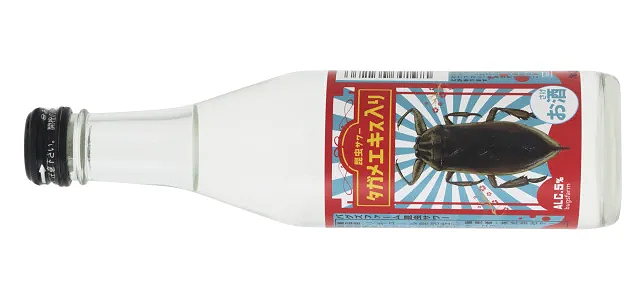
Posted By: Alex - Wed Jan 05, 2022 -
Comments (1)
Category: Inebriation and Intoxicants, Insects and Spiders
Kmarto Wine
In the mid-1980s, K-Mart stores in Gainesville, Florida introduced a K-Mart-branded wine, which they called Kmarto. It cost a mere $1.97, and was available in both a red and white variety.Very little information remains about Kmarto. For instance, I don't know how long it was sold. Just a few years, I think. As far as I know, it was never sold outside of Gainesville.
I was only able to find one picture of a bottle of the stuff — on, of all places, The Horse Doctor (a veterinarian's blog):
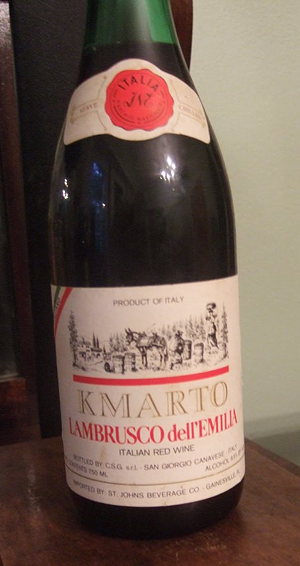
If you happen to still own a bottle of this stuff, I'm sure you could easily sell it for a couple of hundred dollars, because it's definitely a collector's item. As Paul Kirchner has reported in his book Oops!:
Posted By: Alex - Tue Sep 28, 2021 -
Comments (4)
Category: Inebriation and Intoxicants, Alcohol
Always Elvis Wine
Always Elvis wine was released in 1979, two years after Elvis's death. The front label had a picture of Elvis, while the back label featured a poem by Col. Tom Parker.Parker reportedly said that Always Elvis was the kind of wine Elvis "would have drunk if he'd liked the stuff."
At the time it sold for $4 a bottle. Now an unopened bottle of it will cost you upwards of $150.
However, there are other, newer Elvis Presley wines on the market, such as 'The King' wine, available at ElvisPresleyWines.com.
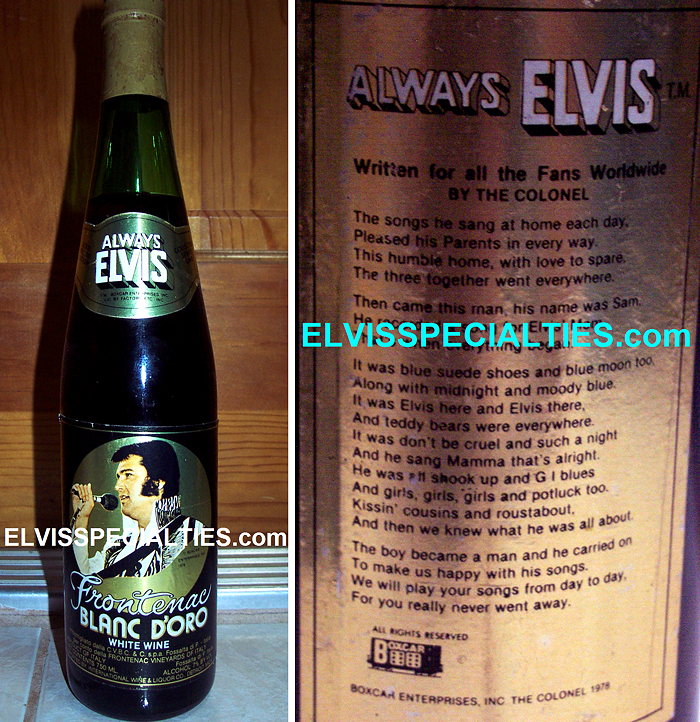
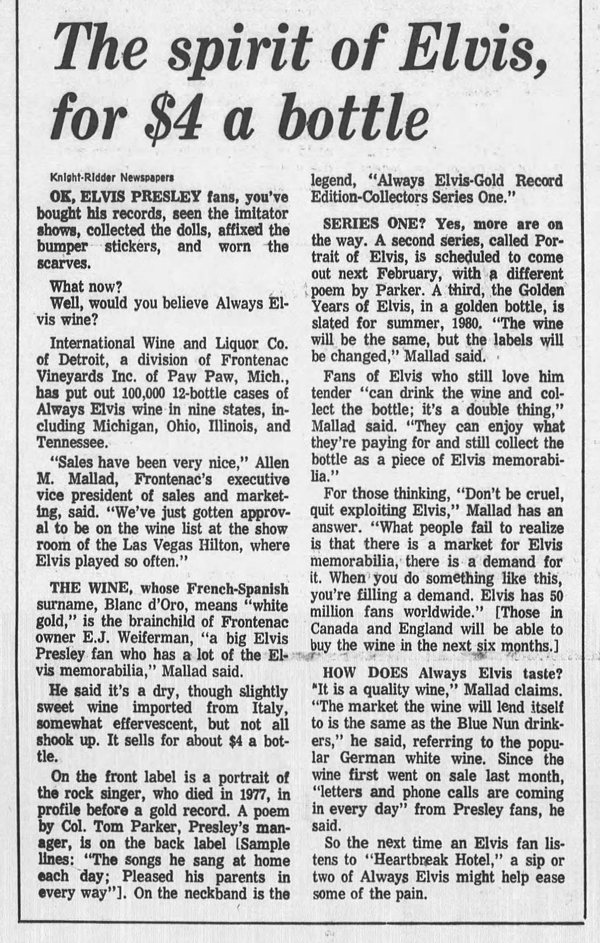
Chicago Tribune - Nov 4, 1979
Posted By: Alex - Fri Aug 27, 2021 -
Comments (4)
Category: Celebrities, Inebriation and Intoxicants, Music
“I thought the Kama Sutra was an Indian restaurant”
Smirnoff ran this ad in the 70s but reportedly pulled it after a few months when its market researchers surveyed customers and discovered that "60 per cent of them thought that the Kama Sutra was indeed an Indian restaurant."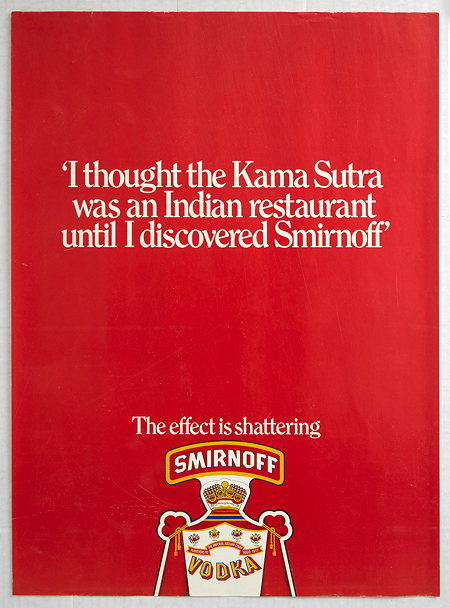
image source: codex
But according to Delia Chiaro in The Language of Jokes, the ad lived on in popular memory, inspiring a genre of "Smirnoff jokes".
I thought innuendo was an Italian suppository until I discovered Smirnoff.
I thought cirrhosis was a type of cloud until I discovered Smirnoff.
However it was not long before the graffitists began to abandon the formula, first by substituting the word Smirnoff with other items:
I thought Nausea was a novel by Jean-Paul Sartre until I discovered Scrumpy.
Soon, the caption began to move more radically away from the matrix, as more items were changed. In the next example there is no allusion to drink whatsoever:
I used to think I was an atheist until I discovered I was God.
Although Smirnoff jokes are now practically obsolete, the I thought A was B until I discovered C formula has now frozen into the English language as a semi-idiom. Today we can find graffiti (or indeed hear asides) such as:
I used to talk in cliches but now I avoid them like the plague
in which the original matrix is barely recognizable.
Below is another Smirnoff ad from the same series.
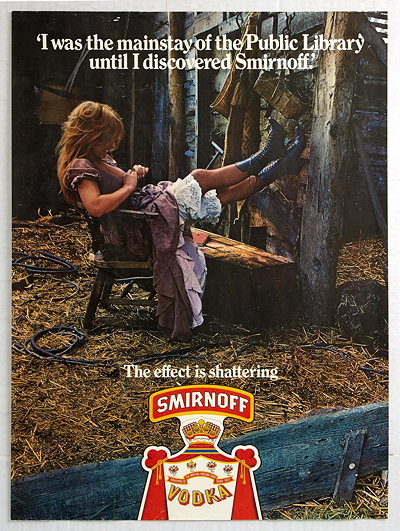
Posted By: Alex - Wed Aug 11, 2021 -
Comments (5)
Category: Inebriation and Intoxicants, Advertising, 1970s, Jokes
Octogenarian Teetotalers
Published by the National Temperance League of London in 1897. It contained 113 portraits of teetotalers who were over the age of 80.Unfortunately, there was no companion volume of Octogenarian Tipplers.


image source: Bizarre Books
Posted By: Alex - Thu Jul 29, 2021 -
Comments (2)
Category: Elderly and Seniors, Inebriation and Intoxicants, Books
Flagon and Trencher Society
In order to become a member of the Flagon and Trencher society, one has to satisfy the following rule of eligibility: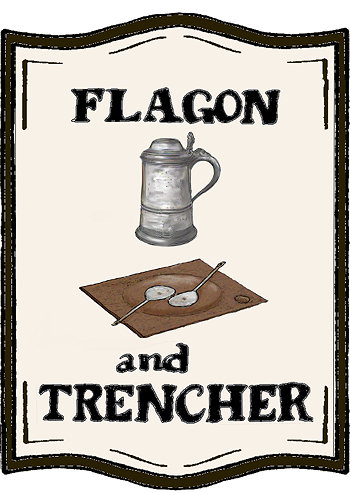
According to their website, the society was founded in 1962 by Walter Lee Shepard and the late Kenneth Stryker-Rodda. As of 2002, they had more than 1000 members.
There's a $200 fee to apply to join. But if you apply and can't satisfactorily prove descent from a colonial barkeep, you'll only get a portion of that fee back.
Posted By: Alex - Thu Jul 08, 2021 -
Comments (0)
Category: Clubs, Fraternities and Other Self-selecting Organizations, Inebriation and Intoxicants
Earl Grey Tea Intoxication
As reported in the April 17, 2002 issue of The Lancet:After 3 weeks, they also occurred in the left foot. After 5 weeks, muscle cramps had spread towards the hands and the right calf. Occasionally, he observed fasciculations of the right adductor pollicis and gastrocnemius. Additionally, he noted distal paraesthesias in all limbs, and a feeling of pressure in his eyes, associated with blurred vision, particularly in darkness...
The patient assumed that there was a relation between his symptoms and his tea consumption, and stopped drinking Earl Grey after 5 months, reverting to pure black tea again. Within 1 week, his symptoms had completely disappeared. Symptoms also remained absent if he completely withdrew from tea, which he did in the nature of experiment, for about a week. He found that his symptoms did not recur as long as he consumed no more than 1 L of Earl Grey daily.
When last seen in November, 2001, neurological examination, nerve conduction studies, and electromyography were normal. He was still drinking 2 L of plain black tea daily (his entire fluid intake), and had no complaints.
The moral of his story is that 2 liters of tea a day is apparently fine. But 4 liters is asking for trouble.

via reddit
Posted By: Alex - Mon Jun 21, 2021 -
Comments (3)
Category: Inebriation and Intoxicants, Coffee and other Legal Stimulants

| Who We Are |
|---|
| Alex Boese Alex is the creator and curator of the Museum of Hoaxes. He's also the author of various weird, non-fiction, science-themed books such as Elephants on Acid and Psychedelic Apes. Paul Di Filippo Paul has been paid to put weird ideas into fictional form for over thirty years, in his career as a noted science fiction writer. He has recently begun blogging on many curious topics with three fellow writers at The Inferior 4+1. Contact Us |




